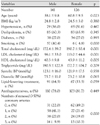Abstract
Background and Objectives
Carotid intima media thickness (IMT) is associated with an increased risk of cardiovascular events whereas the Framingham risk score (FRS) is globally used to evaluate cardiovascular risk. We sought to evaluate the relationship between carotid IMT and FRS in Korean patients with coronary arteriosclerosis.
Subjects and Methods
The study population consisted of angiographically proven 267 consecutive patients with coronary arteriosclerosis (mean age 59 years, 141 males). Carotid IMT was measured by high-resolution ultrasound and semiautomatic methods. The FRS was derived from the algorithm published in the National Cholesterol Education Program Adult Treatment Panel III guidelines (NCEP-ATP III) using age, gender, smoking, systolic blood pressure level, use of antihypertensive treatment and total and high-density lipoprotein cholesterol levels.
Results
Carotid IMT correlated with the FRS in men (r=0.307, p<0.001) and in women (r=0.429, p<0.001). The severity of CAD, which was graded on the number of stenosed major coronary arteries more than 50%, showed a significant positive correlation with the FRS (r=0.266, p<0.001) and carotid IMT (r=0.166, p=0.007). The mean value of the FRS in patients with carotid plaque was higher than in patients without carotid plaque (15.0±3.9 and 12.0±4.4, p<0.001). The FRS was independently associated with carotid IMT in men and women (β=6.433, p=0.001 and β=11.271, p<0.001, respectively).
Conclusion
The FRS for primary prevention was significantly associated with carotid IMT even in patients with CAD and also a correlation with the severity of CAD. The FRS may be helpful to predict the prognosis in patients with coronary arteriosclerosis such as carotid IMT and a prospective cohort study may be required to certify the usefulness of the FRS.
Figures and Tables
 | Fig. 1Plots of age vs CCA IMT in men (A) and women (B). Regression lines are shown. There are statistically significant correlation between age and CCA IMT in men (r=0.187, p=0.027) and women (r=0.315, p<0.001). CCA: common carotid artery, IMT: intima media thickness. |
 | Fig. 2Plots of Framingham risk scores vs CCA IMT in men (A) and women (B). Regression lines are shown. There are statistically significant correlation (p<0.001) between Framingham risk scores and CCA IMT in men (r=0.307) and women (r=0.429). CCA: common carotid artery, IMT: intima media thickness. |
References
1. Salonen R, Salonen JT. Progression of carotid atherosclerosis and its determinants: a population-based ultrasonography study. Atherosclerosis. 1990. 81:33–40.
2. Lonn E. Carotid artery intima-media thickness: a new noninvasive gold standard for assessing the anatomic extent of atherosclerosis and cardiovascular risk. Clin Invest Med. 1999. 22:158–160.
3. Aminbakhsh A, Mancini GB. Carotid intima-media thickness measurements: what defines an abnormality?: a systemic review. Clin Invest Med. 1999. 22:149–157.
4. Simon A, Gariepy J, Chironi G, Megnien JL, Levenson J. In tima-media thickness: a new tool for diagnosis and treatment of cardiovascular risk. J Hypertens. 2002. 20:159–169.
5. Chambless LE, Heiss G, Folsom AR, et al. Association of coronary heart disease incidence with carotid arterial wall thickness and major risk factor: the Atherosclerosis Risk in Communities (ARIC) Study, 1987-1993. Am J Epidemiol. 1997. 146:483–494.
6. Kannel WB, McGee D, Gordon T. A general cardiovascular risk profile: the Framingham Study. Am J Cardiol. 1976. 38:46–51.
7. Menotti A, Puddu PE, Lanti M. Comparison of the Framingham risk function-based coronary chart with a risk function from an Italian population study. Eur Heart J. 2000. 21:365–370.
8. Touboul PJ, Vicaut E, Labreuche J, et al. Correlation between the Framingham risk score and intima media thickness. Atherosclerosis. 2006. 192:363–369.
9. National Cholesterol Education Program (NCEP) Expert Panel on Detection, Evaluation, and Treatment of High Blood Cholesterol in Adults (Adult Treatment Panel III). Third report of the National Cholesterol Education Program (NCEP) expert panel on detection, evaluation, and treatment of high blood cholesterol in adults (Adult Treatment Panel III), final report. Circulation. 2002. 106:3143–3421.
10. Furberg CD, Byington RP, Borhani NA. Multicenter isradipine diuretic atherosclerosis study (MIDAS). Am J Med. 1989. 86:37–39.
11. Lee JK, Lee SY, Cho BM, Kim YJ. Ideal body mass index and level of body mass index for management of obesity. J Korean Soc Study Obes. 2001. 10:356–365.
12. Lekakis JP, Papamichael C, Papaioannou TG, et al. Intima-media thickness score from carotid and femoral arteries predicts the extent of coronary artery disease: intima-media thickness and CAD. Int J Cardiovasc Imaging. 2005. 21:495–501.
13. Bae JH, Seung KB, Jung HO, et al. Analysis of Korean carotid intima-media thickness in Korean healthy subjects and patients with risk factors: Korea multi-center epidemiological study. Korean Circ J. 2005. 35:513–524.
14. Park KR, Kim KY, Yoon SM, Bae JH, Seong IW. Correlation between intima-media thickness in carotid artery and the extent of coronary atherosclerosis. Korean Circ J. 2003. 33:401–408.
15. Kablak-Ziembicka A, Tracz W, Przewlocki T, Pieniazek P, Sokolowski A, Konieczynska M. Association of increased carotid intima-media thickness with the extent of coronary artery disease. Heart. 2004. 90:1286–1290.
16. Hollander M, Hak AE, Koudstaal PJ, et al. Comparison between measures of atherosclerosis and risk of stroke: the Rotterdam Study. Stroke. 2003. 34:2367–2372.




 PDF
PDF ePub
ePub Citation
Citation Print
Print







 XML Download
XML Download